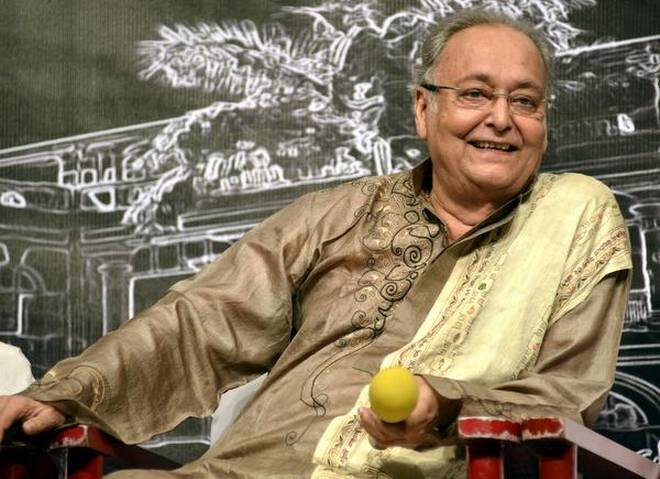SOUMITRA CHATTERJEE 1935-2020 | MOVIES

The actor, even in his mid-eighties, was not only active but also highly sought-after. Terms like ‘has-been’ or ‘yesteryear’ never applied to him
A piece of information, by itself, is dead wood – like a piece from a jigsaw puzzle – which comes to life only when you collate it with other pieces. Take actor Soumitra Chatterjee’s date of birth, for example. The fact that he was born on January 19, 1935 doesn’t say much about him. But if you place that date against October 1, 2020, when he last reported for a shoot before showing symptoms of COVID-19, you realise he was no ordinary actor but someone who was professionally active even when nearing 86.
Not many lead actors continue to work – or get work – at 86. None actually, if you discount Clint Eastwood, Kirk Douglas, Christopher Plummer and maybe a couple of other names that don’t lend to easy recall. Back home, there was exception in the form of Dev Anand, who continued to work until he died at 88, but by then he was long past his prime and was making those films only to feed his vanity.
But Chatterjee, even in his mid-eighties, was not only active but also highly sought-after. Terms like ‘has-been’ or ‘yesteryear’ never applied to him. Ernest Hemingway once said that no writer ever produced anything worthwhile after winning the Nobel; the same holds true for the Dadasaheb Phalke award in Indian cinema, in the sense that it invariably comes at a time when the awardee’s productive years are spoken of in the past tense. But not for Chatterjee. He got the award in 2012, and ever since then he got only busier by the year. In 2019, he had as many as 15 releases; and in the pandemic-hit 2020, almost as many of his films either released or are lined up for release.
So, how does one define Soumitra Chatterjee?
If you label him as a Satyajit Ray actor – they worked together in 14 films – his knowledgeable fans will instantly point out that he worked with numerous other directors too and that those 14, even though they brought him acclaim, form only a small percentage of the more than 300 films he did during his lifetime. In fact, with the notable exceptions of Ritwik Ghatak (whom Chatterjee claimed to have punched once, during a debate back in the 1960s) and Buddhadeb Dasgupta, he worked with nearly all directors, including Tapan Sinha, Mrinal Sen and Tarun Majumdar.
If you label him as a cinema actor, people will remind you that he did theatre too.
If you label him as an actor, someone or the other is bound to tell you that he was a painter, poet and an activist as well.
If you identify him as Feluda, there will be someone disagreeing: ‘No, he was more popular as Apu.’
If you classify him as a Calcuttan or a Bengali, they will say he was global, decorated twice by the French, with Order of Arts and Letters and with the Legion of Honour.
More an actor than a ‘hero’
But in debate-loving Bengal, one thing remains indisputable: that for several generations of Bengalis, the mention of the word ‘actor’ instantly brought two names to mind, Uttam Kumar and Soumitra Chatterjee. There were the two colossuses. After Kumar, nearly a decade older and far more popular of the two, died at the age of 54 in 1980, Chatterjee became the lone flag-bearer of meaningful Bengali cinema.
Chatterjee was one of those very few Indian actors who, even while playing the lead in commercial movies, was acknowledged more as an actor than a ‘hero’ – a hero being someone one who can jump off a tall building without a scratch and can knock out a dozen bad guys with his bare hands.
While it was only fairly recently that some fresh air swept through Bollywood with the arrival of Irrfan Khan, Ayushmann Khurrana, Nawazuddin Siddiqui and Rajkummar Rao – mainstream actors who could draw crowds even without fight scenes – Chatterjee was all of them rolled into one, right from the black-and-white era. And considering that he was around for 61 long years, almost every Bengali – from nonagenarians down to teenagers – lovingly preserves in mind his or her own image of Chatterjee: the innocent Apu; the charming Amal of Charulata; the daring Feluda; the resolute swimming coach in Kony; the middle-aged man next door; the genial grandfather. His very presence on the screen was assuring: for filmmakers and audiences alike.
His passing is akin to the falling of an ancient tree. But while the tree is gone, its shade remains. It wouldn’t be entirely wrong to say that the trunk of the tree was essentially made of the 14 films he did for Ray. For, one will always wonder how Chatterjee’s career would have fared without Ray. For that matter, one can also wonder how Ray’s films would have fared without Chatterjee.
That’s something Bengal can now debate.
source: http://www.thehindu.com / The Hindu / Home> Entertainment> Movies / by Bishwanath Ghosh / November 15th, 2020